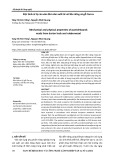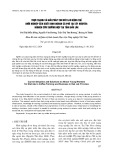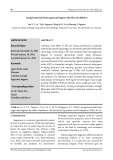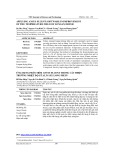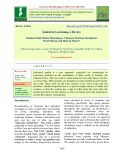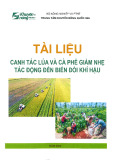
Vietnam Journal
of Agricultural
Sciences
ISSN 2588-1299
VJAS 2024; 7(3): 2251-2259
https://doi.org/10.31817/vjas.2024.7.3.07
2251
Vietnam Journal of Agricultural Sciences
Received: March 28, 2024
Accepted: August 20, 2024
Correspondence to
maudung@vnua.edu.vn
ORCID
Nguyen Mau Dung
https://orcid.org/0000-0003-3351-
6452
Factors Affecting the Labor Productivity of
Garment Firms in Nam Dinh Province,
Vietnam
Nguyen Mau Dung1 & Phan Thi Minh Phuong2
1 Faculty of Economics and Rural Development, Vietnam National University of
Agriculture, Hanoi 12400, Vietnam
2 Faculty of Management and Marketing, University of Economics – Technology for
Industries, Hanoi 11600, Vietnam
Abstract
Under the impacts of the 4th Industrial Revolution, garment firms
in Vietnam are facing various challenges, and improvement in their
labor productivity is one of the important measures to overcome these
challenges. This study, therefore, investigated the determinants of the
labor productivity of garment firms in Nam Dinh province. The data
used for this study were extracted from the Enterprise Survey Dataset
in 2021, and descriptive statistics, comparative analysis, and the
Cobb-Douglas function in logarithm form were the major methods
employed for the study. The study findings underscored the positive
impacts of fixed assets and business management costs, average
payments to employees, exporting activities, and the utilization of
internet resources on labor productivity. The study revealed that firm
size, gender composition, and age of firm leaders do not significantly
influence labor productivity, emphasizing the complexity and
industry-specific nuances of these relationships. Based on the
insights gained from the study, several strategic suggestions were
proposed to improve the labor productivity of garment firms in Nam
Dinh province in the future.
Keywords
Determinants, Garment firms, Labor productivity, Nam Dinh
province
Introduction
Labor productivity is one of the crucial factors that significantly
influences the competitiveness and operational efficiency of firms, as
well as the overall economic performance of each country (GSO,
2021). Labor productivity and the factors affecting it are consistently
subjects of evaluation by firms to devise reasonable solutions that
contribute to enhancing labor productivity and improving the
competitive capacity of firms or the firms’ ability to effectively compete

Factors affecting the labor productivity of garment firms in Nam Dinh province, Vietnam
2252
Vietnam Journal of Agricultural Sciences
in their market or industry. Higher labor
productivity could enable firms to save costs
and increase economic efficiency, while lower
labor productivity may lead to various
challenges and even the risk of bankruptcy (Bui
Thu Ha et al., 2023).
Nam Dinh is a province located in the Red
River Delta of Vietnam, and has a rich tradition
and extensive experience in the production and
management of the textile and garment industry.
The province has an abundant textile and
garment labor force with high-level skills.
During the period of 2016-2020, the production
value of the textile and garment, leather, and
footwear industries in the province grew at an
average rate of 14% per year, accounting for 49%
of the total industrial production value in the
province (Thang Long, 2021). Within the textile
and garment industry in Nam Dinh, garment
firms constitute the majority, approximately 70%
of the total number of firms. However, the
garment industry in Vietnam as a whole, and
specifically in Nam Dinh, is facing numerous
challenges due to the impact of the Fourth
Industrial Revolution and the deepening process
of globalization. Several garment firms are even
operating at a loss and are at risk of ceasing
production (Thanh Hai, 2022). To overcome
these challenges, it is crucial to focus on
improving labor productivity in garment firms in
Nam Dinh province since the labor productivity
of garment firms in Vietnam has been found to
be quite low in comparison with other countries
like China and the Philippines (Nguyen Anh Bac,
2015; Le Thi Thu Huong, 2016). Therefore, this
study was conducted to analyze the factors
influencing the labor productivity of garment
firms, and then to propose solutions for
enhancing the labor productivity of garment
firms in Nam Dinh province in the near future.
Productivity is a key to maintaining
competitiveness at both the organization and
country levels, and in ensuring sustainable
development. In general, productivity is the
relationship between the output (goods and
services produced) and the inputs or resources
such as labor, materials, machinery, and energy
that are used in production (Samuelson &
Nordhaus, 2009). Though there are various
aspects of productivity, including labor
productivity, capital productivity, and total factor
productivity, labor productivity is very important
because labor is a dominant and active factor
used in the production process (Sarwar et al.,
2021). Labor productivity can be specifically
calculated by dividing a measure of output by a
measure of labor input. Output refers to a
quantity of goods and services produced in a
given time period, total revenue (i.e. total value
of goods and services produced), or gross value
added (i.e. total value of goods and services
minus the value of inputs used for producing
goods and services). In contrast, labor input can
be measured as either the number of
employees/workers or the number of worked
hours of employees/workers (Phyu, 2023).
Many scholars (Sharp et al., 2008; Heshmati
& Rashidgalan, 2018; Samargandi, 2018;
Tekleselassie et al., 2018; Phyu, 2023) have
made efforts to identify the determinants of labor
productivity at the firm level in various
industries. Based on those studies, the
determinants of labor productivity at the firm
level can be grouped into several categories,
namely: (1) basic characteristics of the firms
(age, type of firm); (2) managerial capacity of
firm owners (age, education, gender,
professional expertise); (3) labor force and
related factors (number of employees, rate of
females, rate of trained employees, wage rate);
(4) capital and technology (capital intensity,
fixed asset value per laborer, application of
technology innovation); and (5) other
(government and local policies, public
infrastructure, and market openness, etc.). The
determinants of labor productivity and their
extents in the studies are quite various due to the
data available as well as the specific
characteristics of different industries and firms in
the study countries. Heshmati & Rashidgalan
(2018) examined labor productivity and its
determinants within the manufacturing sector of
Kenya. Using cross-sectional data, they found
that factors such as wage rate, education,
training, and capital intensity were the key
determinants that positively impacted labor
productivity. Additionally, the presence of a
significant proportion of females in the labor

Nguyen Mau Dung & Phan Thi Minh Phuong
https://vjas.vnua.edu.vn/
2253
force was associated with a decline in labor
productivity. Samargandi (2018) analyzed the
determinants of labor productivity in MENA
(Middle Eastern and North American) countries,
employing panel data spanning the years 1980 to
2014. The research revealed positive associations
between labor productivity and factors such as
human capital, financial development, trade
openness, and capital stock while there was a
negative correlation observed between
compensation and labor productivity. Phyu
(2023) used data from 172 garment firms in
Yangon, Myanmar to determine the factors
affecting the labor productivity of garment
manufacturing firms. The study concluded that
the labor productivity of the garment firms in
Myanmar is influenced by various factors,
including human capital, management practices,
the compensation and rewards structure, the
implementation of employee welfare programs,
and some external factors such as government
regulations and policies, public infrastructure,
and the national culture.
In this study, we firstly described the
garment industry as a whole as well as basic
information of garment firms in Nam Dinh
province. Secondly, we examined the effects of
the various factors on labor productivity of
garment firms using the regression model.
Finally, we made some implications for
improving the labor productivity of garment
firms in Nam Dinh province in the future.
Methodology
Secondary data, which included the
development status of the garment industry and
the number of enterprises in the garment industry
in Nam Dinh province, were collected from the
Provincial Statistical Yearbook of Nam Dinh and
consolidated reports from the Department of
Industry and Trade of Nam Dinh province, as
well as from publicly available documents.
Primary data, which included the basic situation
of the enterprises, labor force, and business
production results in the garment industry in
Nam Dinh province, were extracted from the
Enterprise Survey Data of the General Statistics
Office in 2021. This survey was conducted to
collect data from all the enterprises and
cooperatives in Vietnam based on standard
questionnaire sets under the supervision of the
General Statistics Office in Vietnam. The details
of the survey procedures and questionnaire sets
were published in the guidance notes for the 2021
Enterprise Survey (General Statistics Office,
2020). Descriptive statistics and comparative
analysis were the main methods used to analyze
the labor forces, production, and business
situations of the garment firms in the province.
To analyze the factors influencing labor
productivity in the garment enterprises in Nam
Dinh province, we departed from a standard
Cobb-Douglas function production as specified
in equation: Y = AKαLβeɛ (1)
where Y denotes the production output, A
refers to the total factor productivity, K and L
represent two basic production inputs, with K
being the capital and L being the labor used for
production, and ɛ is known as the error term.
From equation (1), the labor productivity
was calculated as follows:
LP =𝑌
𝐿= A𝐾α𝐿β𝑒ɛ
𝐿 (2)
Taking the natural logarithm of equation (2),
we obtained the following equation:
LnLP = LN(𝑦
𝑙) = LnA + αLn(𝐾
𝐿) + (β+α -
1)LnL + ɛ (3)
Labor productivity can be measured by
several ways. Based on the available dataset and
empirical model, labor productivity of the
garment firms in this paper was measured by the
ratio of gross value added and total employees in
the firms in Nam Dinh province. The independent
variables or predictors for estimating their effects
on labor productivity of the garment firms in Nam
Dinh province were: labor force (or total number
of employees); fixed asset value per laborer; and
age, gender, professional level, and nationality of
firm owners. Based on the general equation (3),
and the model used by Papadogonas & Voulgaris
(2005) and Pham & Nguyen (2017) for estimating
the determinants of labor productivity, in this
study we used the empirical model as follows:

Factors affecting the labor productivity of garment firms in Nam Dinh province, Vietnam
2254
Vietnam Journal of Agricultural Sciences
Table 1. Variable definitions and measurements
Variable label
Variable definition and measurement
LP (lnLP)
Labor productivity measured by the gross value added (million VND) divided by the total number of
employees in the firm (number of persons)
AFC (LnAFC)
Average fixed cost measured by the total fixed cost (million VND) divided by the total number of
employees in the firm (number of persons)
AMC (lnAMC)
Average management cost measured by the total management cost (million VND) divided by the total
number of employees in the firm (number of persons)
A_PAY (LnA_PAY)
Average payment measured by the total payment (million VND) divided by the total number of
employees in the firm (number of persons)
L
Total number of employees in the firm (number of persons)
FR (LnFR)
Rate of female employees in the firms measured by the ratio of the total number of female employees
and total number of employees
AGE (lnAGE)
Age of the firm owner (number of years)
GENDER
Gender of the firm owner: equal to 1 if the firm owner is male, and 0 for otherwise
EDU
Education level of the firm owner: equal to 1 if the firm owner has a college degree or higher education,
and 0 for otherwise
NATION
Nationality of the firm owner: equal to 1 if the firm owner is Vietnamese, and 0 for otherwise
EXPORT
Exportation status of the firm: equal to 1 if the firm exports garment products, and 0 for otherwise
INTERNET
Status of internet use in the firm: equal to 1 if the firm uses the internet for e-trade or other business
transactions, and 0 for otherwise
SOFTWARE
Status of software use in the firm: equal to 1 if the firm uses specific software for business
management, and 0 for otherwise
INNOVATION
Status of innovation in the firm: equal to 1 if the firm has innovative products, business model, or
procedures, and 0 for otherwise
LnLPi = β0+ β1Ln TFCi
Li
+ β2Ln TMCi
Li
+ β3Ln T_PAYi
Li
+ β4LnLi + β5LnFRi + β6GENDERi+ β7EDUi +
β8NATIONi+ β9EXPORTi+ β10INTERNETi + β11SOFTWAREi + β12INOVATIONi + ɛi (4)
Then we had:
LnLPi = β0+ β1LnAFCi + β2LnAMCi + β3LnA_PAYi+ β4LnLi + β5LnFRi + β6GENDERi+
β7EDUi + β8NATIONi+ β9EXPORTi+ β10INTERNETi + β11SOFTWAREi + β12INOVATIONi + ɛi
(5)
where the dependent variable is the natural
logarithm of labor productivity. The OLS
(Ordinary Least Square) method was used to
estimate the coefficients of the model. The
variable definitions and measurements are
presented in Table 1.
There were 206 garment firms in Nam Dinh
province in the available survey dataset.
However, some firms were very small with a
labor force of only 1 to 3 persons, and some firms
did not have enough necessary data for analysis
and modeling. For better securing the confidence
of the model estimation, those firms were
excluded from the dataset. Finally, the data of the
remaining 151 garment firms in Nam Dinh
province were used for model estimation.
Results and Discussion
Overview of the development of the garment
industry in Nam Dinh province
During the period of 2015-2020, the
business performance of garment firms in Nam
Dinh province showed quite impressive growth.
The total ready-made garment production of
garment firms in the province increased from
221.3 million units in 2015 to 307.6 million units
in 2020, achieving an average annual growth rate
of 6.81% (Table 2). The gross revenue and pre-

Nguyen Mau Dung & Phan Thi Minh Phuong
https://vjas.vnua.edu.vn/
2255
Table 2. Business performance of garment firms in Nam Dinh in the 2015-2020 period
Indicator
Unit
2015
2018
2019
2020
Growth
rate/year (%)
1. Total quantity of ready-made products
Mil. product
221.3
257.5
273.2
307.6
6.81
2. Total capital of the garment industry
Bil. VND
9,337.7
16,271.5
18,619.9
19,580.4
15.96
3. Gross revenue
Bil. VND
12,999.6
21,305.9
24,336.4
22,908.7
12.00
4. Total income of laborers in the garment
industry
Bil. VND
2,522.5
4,534.9
5,013.0
5,508.9
16.91
5. Income per laborer per month
Mil VND
4.41
5.96
6.52
7.22
10.36
6. Pre-tax profit of the garment industry
Bil. VND
666.8
992.5
923.5
1308.6
14.44
7. Production index of the garment industry
%
106.51
120.51
114.79
125.45
21.00
Source: Nam Dinh Statistics Office (2021)
tax profit of garment firms also increased at
relatively high rates, reaching 12.0% and 14.4%
per year, respectively. The average income of
laborers in the garment firms increased by
10.36% per year during the period of 2015-2020,
reaching 7.22 million VND/person/month in
2020. This income level was higher than the
average income of laborers working in
enterprises in the province (7.07 million
VND/person/month).
Basic information of garment firms in Nam
Dinh province
Garment firms were distributed across all ten
districts in the province, with a significant
concentration in Nam Dinh City (37.5%), Y Yen
district (18.6%), Giao Thuy district (7.4%), and
Vu Ban district (6.8%). The data of the 151
garment firms showed that the predominant types
of firms were private limited liability companies,
state-owned joint-stock companies with less than
50% state capital (making up 53.6%), joint-stock
companies without state capital (23.2%), and
100% foreign-owned enterprises (18.5%). The
statistical results indicated that 83.4% of the firm
owners were Vietnamese, and the remaining
were Korean, Chinese, Japanese, and Taiwanese
nationalities. The majority of firm owners were
male, constituting 80.17% of the total. In terms
of professional level, 75.5% of firm owners
completed college or university or had some
form of higher education. The rate of firms that
exported their garment products accounted for
35.8% (Table 3).
Table 3. Basic information of the garment firms in Nam Dinh province
Variable label
Mean
Std. Dev.
Min
MAX
LP
102.292
48.7
13.8
278.2
AFC
477.017
754.7
8.6
4710.1
AMC
28.349
29.7
0.2
171.8
A_PAY
68.584
30.1
11.5
176.7
L
401.267
1162.0
4.0
10821.0
FR
0.764
0.1
0.2
1.0
AGE
47.272
9.5
30.0
76.0
GENDER
0.801
0.4
0.0
1.0
EDU
0.755
0.4
0.0
1.0
NATION
0.834
0.4
0.0
1.0
EXPORT
0.358
0.5
0.0
1.0
INTERNET
0.695
0.5
0.0
1.0
SOFTWARE
0.444
0.5
0.0
1.0
INNOVATION
0.264
0.4
0.0
1.0



![Tài liệu kỹ thuật tái canh cây cà phê [chuẩn nhất]](https://cdn.tailieu.vn/images/document/thumbnail/2025/20250909/kimphuong1001/135x160/5411757389201.jpg)

